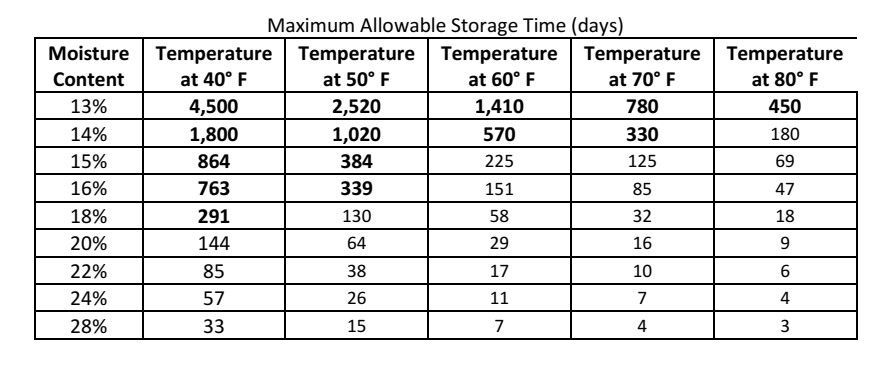- No products in the cart.
The weather is changing, those winter temperatures are leaving, and summer temperatures will soon be on their way. It is now time to think about the corn that has been stored in the bins since last fall and consider the ramifications of keeping it through summer. If your corn is to be stored in that bin past the end of May, it is time to start thinking about warming your grain for summer storage. The temperature of that stored corn should be raised to 60°-65° F for the coming summer months. This raise in temperature will help to prevent the bin from sweating, causing troubles and costing you money. We always recommend not raising the grain temp above 65° F, if possible. Insect and mold activity seems to start above that 65° F temperature.
One major factor to consider before warming the grain would be the moisture content of that grain when it was finished in that bin last fall. Keeping corn into the summer months or longer is something that should be planned for when dried and placed into the storage bin in the fall. Corn that is being held into the summer months should have been dried to a moisture content of 14% or lower. If it was not dried to 14% or below, and it is still in the bin come spring, you may want to re-think keeping it into the summer months.
Corn, just like any other food product, has a limited storage time based on certain conditions. Below, I have included a table of the 2 most talked about conditions and their effect on storage time.

Example:
(This information assumes the grain was tested accurately, and was cooled immediately to 50° F.)
If your corn was dried to 15% and cooled to 50° F in September, by the end of April 66% of its storage time is now gone. If the temperature is then raised to 60° F, the storage time remaining (33%) will equate to approximately 70 days before one grade is lost. If the temperature had been raised to 70° F, the storage time remaining would then be reduced to 40 days. These greatly reduced storage times will then start to have an impact on your corn grade when sold. A reduction in grade from #1 to #2 and possibly to #3 in today’s market can spell the difference between a profit or a major loss on that bin. If that same corn had been dried to 14%, handled in the same manner and the temp raised to 60° F come spring, there would still be almost one year of storage time remaining at the end of May. Pre-planning for grain being stored in a bin is a must.
There are also steps that you can take that will help improve the quality of the grain being stored over the winter, through the spring and into the summer months. Inspect the grain in your bins weekly. By inspect, we mean visually look at it, smell the air coming from it and if possible keep a check on the temperature of it. You might even consider a bin monitoring and control system for your bins in the future. These systems allow you to monitor both moisture and temperature in the bins, and some can automatically change grain temperatures for you. Another good practice to perform every year is to seal-off (with fan covers or plastic wrap) the aeration fans which will curtail the natural chimney effect occurring in the bin. This cycle of warm air moving through the fan openings & up through the grain column will warm the grain and, as we discussed above, will cause issues for long term storage.
Finally, the most important factor to consider, SAFETY! From now through the summer is when many grain entrapments occur. By now, we all know what should be done in a bin and how we should do it, but do we? We have all heard for years that we should not go into bins alone, walk on unconditioned grain, be in a bin with known flow issues and that we should wear respirators, have safety lines and be prepared for what could happen. How many of us get into that pattern of thinking that it won’t happen to us? I’m not going to preach to you about this, you know it! I’m asking you to practice it! The last thing I want to do is show up on your farm, not for a visit, but for a rescue or a recovery. Yes, I am trained, yes, I prepare for these occurrences, yes, I became a firefighter to help people in my community and I enjoy that, but I do not enjoy seeing friends under those circumstances. Any day I would rather be at your farm for a friendly visit versus a rescue or recovery. Bottom Line BE SAFE!
Be Safe,
Scott Middleton



